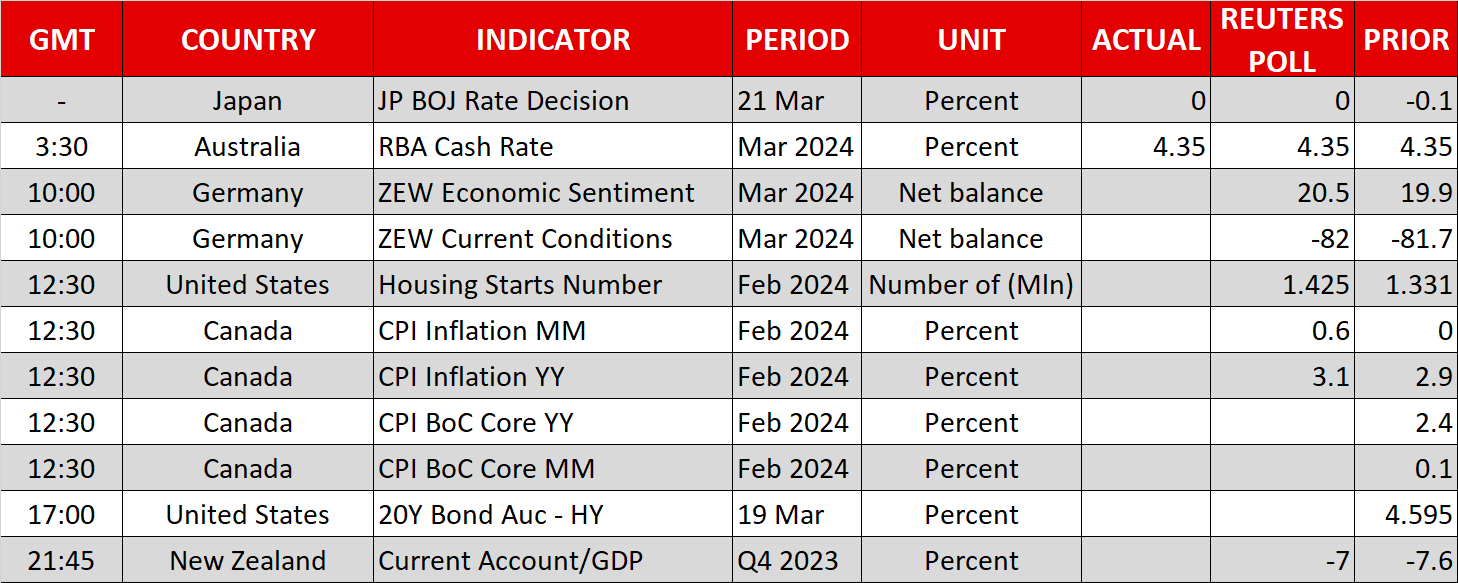BoJ hikes, scraps yield curve control, but yen slumps


BoJ ditches most stimulus-era policies
As had been widely speculated, the Bank of Japan announced an end to eight years of negative interest rates and sharply scaled back its asset purchases after its policy meeting on Tuesday, in a move that had been well telegraphed in the run up to the decision.
Citing that its price stability target had come into sight, the Bank raised its policy rate for the first time in 17 years, lifting it to a range of 0% to 0.1% from -0.1%. The targeting of the yield curve was abolished and ETF purchases were scrapped too, while reducing the amount of corporate bond purchases. However, policymakers maintained their monthly bond buying program of 6 trillion yen and pledged to intervene should there be a rapid rise in long-term interest rates, suggesting the Bank is not yet ready to completely abandon control over the 10-year yield.
Hence, whilst today’s decision went further than many had anticipated, there is a sense that the BoJ still has some doubts about the inflation outlook and the strength of the economy. Governor Ueda told reporters in his press conference that “it's necessary to maintain accommodative monetary conditions even under a normal monetary policy framework”.
Yen back to where it started
With few clues about the possibility of further rate hikes and any future balance sheet reductions, the yen slumped against major currencies such as the US dollar, euro and pound, tracking the plunge in the 10-year JGB yield, though it fared somewhat better against the antipodean pairs.
The yen has now almost fully retraced its March gains made on the back of the reports that the BoJ is poised to exit negative rates. But there could yet be hope for the Japanese currency come the April meeting when the BoJ will update its forecasts based on the outcome of the spring wage negotiations.
It may well be that today’s announcement was just the first step towards policy normalization as it’s still possible that wage growth and inflation will exceed the Bank’s cautious expectations. Moreover, CPI data due out of Japan on Friday is forecast to point to a reacceleration in the core reading and that could also trigger a bit of a correction in the yen given that the selloff seems to be somewhat overdone.
Aussie skids after RBA
Another currency struggling on Tuesday is the Australian dollar. The Reserve Bank of Australia kept interest rates unchanged earlier today, as was widely expected. But policymakers softened their tightening bias, with Governor Bullock saying that the risks to the outlook were “finely balanced”. In each of the previous two meetings, the RBA had considered whether to hike rates again.
Investors anticipate the first RBA rate cut to come in September, but the odds for an August move have gone up. The aussie was last trading about 0.85% lower against its US counterpart, and the kiwi slid by a similar amount.
Dollar resumes rebound ahead of Fed
The euro and pound also lost ground versus the greenback, which was headed towards two-and-a-half-week highs against a basket of currencies.
There’s likely to be some catchup involved in today’s dollar strength following the steep rise in Treasury yields over the past week that wasn’t quite matched in FX markets.
The Federal Reserve will be the next central bank this week that meets on Wednesday and there is some anxiety about the updated dot plot. Following a string of stronger-than-expected US data, including on inflation, investors are worried that FOMC members will pencil in just two rate cuts this year compared to the current three.
Wall Street and gold get the Fed jitters
The revived concerns about sticky inflation have also started to weigh on equity markets. The S&P 500 has been flat over the past week, while the Nasdaq has drifted somewhat lower. But both indices recorded solid gains on Monday amid a bounce back in tech stocks.
Gold traders were also cautious ahead of tomorrow’s FOMC decision, as a hawkish Fed could spur a deeper pullback for the yellow metal from its all-time high of $2,194.99/oz.






















